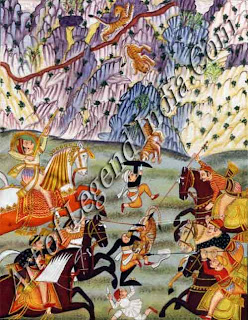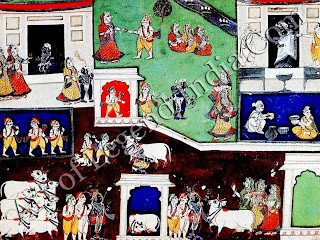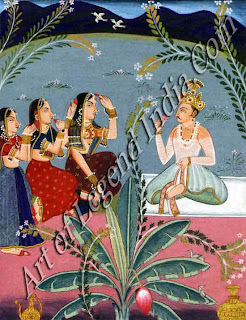 Art is a unique example of
expressing a cultured way of life. The experience of joy relating to the
visible or invisible physical or astral body or sentiments being in real form,
appear before human beings in expressive forms. That expression is termed art.
Art is a unique example of
expressing a cultured way of life. The experience of joy relating to the
visible or invisible physical or astral body or sentiments being in real form,
appear before human beings in expressive forms. That expression is termed art.
The word kala is derived from
Sanskrit. It has been used in Sanskrit literature in numerous interpretations,
in which the 16th parts of a principal object, "a part of time" the
expected intelligence in performing any task deserves special mention. Before
the advent of Bharat Muni, kaki had been applied in almost all other acts of
intelligence except poetry, and was a special world for such work of the
intellect. Any useful business regarding life had ever been placed in the
category of art.
The best example of the
application of the word is clearly discernible in the Natyashastra by Bharat:
"Na tajjanam na tachhilypam na vidyaa na saa kala." The word kala
frequently used by Bharat comes very near to fine art and architecture (shilpa)
is near to a useful art. In India all such knowledge and vocations requiring
the slightest intelligence are termed art, kala.
The Western view of art seems
similar. Art is related to old French art or Latin ars, whose meaning is to
produce, to express or to adjust. Since the 13th century in England the word
art has been used with the meaning intelligence. Since the 17th century the
word has been associated with poetry, music, painting, iconography,
architecture and the fine arts.
According to place, time and
circumstances, the word art has been used in numerous contexts, but still it
has never been deprived of expressing the meaning of intelligent acts and
thoughtful depiction.
From time to time intellectuals
and connoisseurs have defined art in a manner which clearly echoes the meaning
of fine art. To attain the exalted status of Shiv and express the beautiful
form of truth, art is a powerful medium which according to the tastes and
instincts of the artist has been conveyed from time to time for that eternal
depiction. Hence through poetry, music, painting, iconography and through
construction of splendid buildings, the artist from time to time made his
special contribution to society. Among the above five arts painting occupies a
unique status.
 "Chiyate iti
chitram", or the artist sorts out introvert and extrovert sentiments.
Paintings containing sweetness, dynamism and liveliness could be termed beautiful
painting. Owing to such beauty painting is accorded an exalted position. In
ancient India Vishnudharmottara Puran makes the following reference:.
"Kala-naam pravarm chitram dharma kaamartha mokshdam, Mangalyam prathamam
chetadgrihai yatra pratishatham." The art of painting is considered a
subtle means to pursue religion, pleasure and liberation. With this desire for
happiness a painting is installed in the home. Such sentiments have motivated
the decoration of houses with drawings. Frescoes from the Ajanta caves to the
havelis of Shekhawati are a testimony to this view.
"Chiyate iti
chitram", or the artist sorts out introvert and extrovert sentiments.
Paintings containing sweetness, dynamism and liveliness could be termed beautiful
painting. Owing to such beauty painting is accorded an exalted position. In
ancient India Vishnudharmottara Puran makes the following reference:.
"Kala-naam pravarm chitram dharma kaamartha mokshdam, Mangalyam prathamam
chetadgrihai yatra pratishatham." The art of painting is considered a
subtle means to pursue religion, pleasure and liberation. With this desire for
happiness a painting is installed in the home. Such sentiments have motivated
the decoration of houses with drawings. Frescoes from the Ajanta caves to the
havelis of Shekhawati are a testimony to this view.
Lines and colours are the
medium of painting. On any infrasurface the artist could express his feelings
through the application of lines and colours. "On any surface, smooth or
rough, drawing an attractive object with lines of watery, oily or wet or dry
colours is termed painting. Such a depicted object is called a picture. Such
infrasurface chiefly belongs to fresco, stone, wood, utensils and phalaks of
baked clay, ivory, leather, cloth, palm leaves and paper."' The artist
possesses a distinct characteristic to depict heights, distance and nearness on
a plane surface in which he turns his imaginative ideas into visible paintings
through the arrangement of colours and lines according to his capability. Hence
it is said: "Poetry is a speaking picture and a picture is mute
poetry."
Basis
of Painting
 To create paintings artists
have selected different media in accordance with circumstances of time and
space and among them are frequently available paintings in the form of frescoes
and scripts.
To create paintings artists
have selected different media in accordance with circumstances of time and
space and among them are frequently available paintings in the form of frescoes
and scripts.
The art of frescoes belongs to
the instinct of primitive human beings. Ancient cave paintings testify to this
view. The frescoes in the caves of Ajanta, Ellora, Allania4 (Rajasthan) have
attracted worldwide attention of art connoisseurs. Frescoes have been drawn in
temples, palaces and cenotaphs. After the 16th century palaces, temples,
cenotaphs and havelis frequently appeared in temples dedicated to the Vallabha
sect, houses and cenotaphs of feudal lords and palatial buildings (havelis)
belonging to the capitalists of Shekhawati. Frescoes have ever been an ancient
tradition in our country, and accordingly paintings have been produced with new
techniques.
Script
Painting
 In India the tradition of
script painting is very old. Like fresco painting it is still prevalent. From
the commercial angle, drawing of padd and picchavai is done even today in
Rajasthan. In regard to script paintings, a Tantric text of Buddhism titled
Aray Manjushri Kalp says drawing is to be done on clean white cloth which has
borders on both sides. Silk cloth is prohibited for this purpose.
In India the tradition of
script painting is very old. Like fresco painting it is still prevalent. From
the commercial angle, drawing of padd and picchavai is done even today in
Rajasthan. In regard to script paintings, a Tantric text of Buddhism titled
Aray Manjushri Kalp says drawing is to be done on clean white cloth which has
borders on both sides. Silk cloth is prohibited for this purpose.
Script paintings are available
in two forms as padd or picchavai scrolls. Padds are based on stories of folk
gods while picchavais relate to Krishna-Lila. Kundalitpat or scrolls have been
made with less width and more length. The whole text has been painted in this
scroll. A scroll of Bhagvad Puran decorated with 107 paintings of the Alwar
school preserved in the museum at Alwar is the longest scroll in my knowledge.'
Manuscript
Paintings
In ancient days the tradition
of writing poetry and making drawings on bhurj leaves or palm leaves was kept
alive. This resulted in the abundance of pictorial texts preserved in many Jain
homes and museums, and in this Rajasthan's contribution deserves special
mention.
The themes of the pictorial
texts mostly relate to Jainism. Among them KaIpa-Sutra, Kalikacharya
Kathanak and Nentinath Charitra deserve special mention. Texts compiled on palm
leaves had a definite dimension and the reverse sides of different leaves had
been written or painted on. Such leaves had been compiled as texts after making
holes in the centre.
 The invention of paper in the
12th century ushered in a new era in the compilation of pictorial texts.'
Uttarayan Sutra of V.S. 1277 and Nyaya, Tatparya-Tikka compiled by Vachaspati
Mishra in V.S. 1270 and painted on paper are preserved in the Granth-Bhandar of
Jaisalmer. Credit for encouraging this tradition goes to the Sagun-Bhakti
movement and the Mughal rulers of India.
The invention of paper in the
12th century ushered in a new era in the compilation of pictorial texts.'
Uttarayan Sutra of V.S. 1277 and Nyaya, Tatparya-Tikka compiled by Vachaspati
Mishra in V.S. 1270 and painted on paper are preserved in the Granth-Bhandar of
Jaisalmer. Credit for encouraging this tradition goes to the Sagun-Bhakti
movement and the Mughal rulers of India.
The Sagun-Bhakti movement
provided fresh inspiration for folklife. Lilas of Ram and Krishna turned into
reality through the media of poetry and painting. The tradition of painting
texts, making poetry the basis, received a great impetus.
The coming of Mughal rule
popularised the tradition of text painting greatly. Two artists, Sayid Ali and
Abdul Samad, from Persia accompanied Humayun to India and painted the text
Ameer Hamza. In the royal court of Akbar, a keen lover of painting, great
artists like Bassavan, Dasvant, Sanval Dass, Farukh Beg enjoyed imperial
patronage. Besides Babar-Nama, Akbar-Nama, Rajjam-Nama and Tuti-Nama had also
painted religious texts like Mahabharat, Ramayan and Anwar-a-Suhali
(Panchatantra).
After the advent of Akbar the
tradition of manuscript painting gathered momentum. The Mughal school, the
Rajasthani school and the Pahari school were important links in the art of
painting texts based upon Ram Kavya, Krishna Kavya, Sufi Kavya, Riti Kavya,
Barah-Masa, Ritu-Varnan, Rag-Ragini, which are still available.
Miniatures
Miniature art is an offshoot of
manuscript painting. On the basis of imagination or poetical sentiments,
providing a heading or without a title, such miniatures are available in large
numbers in numerous museums and private collections. Laghuchitra or miniature
painting is the heritage of Rajasthani painting.
Writer
– Jai Singh Neeraj
 Art is a unique example of
expressing a cultured way of life. The experience of joy relating to the
visible or invisible physical or astral body or sentiments being in real form,
appear before human beings in expressive forms. That expression is termed art.
Art is a unique example of
expressing a cultured way of life. The experience of joy relating to the
visible or invisible physical or astral body or sentiments being in real form,
appear before human beings in expressive forms. That expression is termed art.  "Chiyate iti
chitram", or the artist sorts out introvert and extrovert sentiments.
Paintings containing sweetness, dynamism and liveliness could be termed beautiful
painting. Owing to such beauty painting is accorded an exalted position. In
ancient India Vishnudharmottara Puran makes the following reference:.
"Kala-naam pravarm chitram dharma kaamartha mokshdam, Mangalyam prathamam
chetadgrihai yatra pratishatham." The art of painting is considered a
subtle means to pursue religion, pleasure and liberation. With this desire for
happiness a painting is installed in the home. Such sentiments have motivated
the decoration of houses with drawings. Frescoes from the Ajanta caves to the
havelis of Shekhawati are a testimony to this view.
"Chiyate iti
chitram", or the artist sorts out introvert and extrovert sentiments.
Paintings containing sweetness, dynamism and liveliness could be termed beautiful
painting. Owing to such beauty painting is accorded an exalted position. In
ancient India Vishnudharmottara Puran makes the following reference:.
"Kala-naam pravarm chitram dharma kaamartha mokshdam, Mangalyam prathamam
chetadgrihai yatra pratishatham." The art of painting is considered a
subtle means to pursue religion, pleasure and liberation. With this desire for
happiness a painting is installed in the home. Such sentiments have motivated
the decoration of houses with drawings. Frescoes from the Ajanta caves to the
havelis of Shekhawati are a testimony to this view.  To create paintings artists
have selected different media in accordance with circumstances of time and
space and among them are frequently available paintings in the form of frescoes
and scripts.
To create paintings artists
have selected different media in accordance with circumstances of time and
space and among them are frequently available paintings in the form of frescoes
and scripts. In India the tradition of
script painting is very old. Like fresco painting it is still prevalent. From
the commercial angle, drawing of padd and picchavai is done even today in
Rajasthan. In regard to script paintings, a Tantric text of Buddhism titled
Aray Manjushri Kalp says drawing is to be done on clean white cloth which has
borders on both sides. Silk cloth is prohibited for this purpose.
In India the tradition of
script painting is very old. Like fresco painting it is still prevalent. From
the commercial angle, drawing of padd and picchavai is done even today in
Rajasthan. In regard to script paintings, a Tantric text of Buddhism titled
Aray Manjushri Kalp says drawing is to be done on clean white cloth which has
borders on both sides. Silk cloth is prohibited for this purpose.  The invention of paper in the
12th century ushered in a new era in the compilation of pictorial texts.'
Uttarayan Sutra of V.S. 1277 and Nyaya, Tatparya-Tikka compiled by Vachaspati
Mishra in V.S. 1270 and painted on paper are preserved in the Granth-Bhandar of
Jaisalmer. Credit for encouraging this tradition goes to the Sagun-Bhakti
movement and the Mughal rulers of India.
The invention of paper in the
12th century ushered in a new era in the compilation of pictorial texts.'
Uttarayan Sutra of V.S. 1277 and Nyaya, Tatparya-Tikka compiled by Vachaspati
Mishra in V.S. 1270 and painted on paper are preserved in the Granth-Bhandar of
Jaisalmer. Credit for encouraging this tradition goes to the Sagun-Bhakti
movement and the Mughal rulers of India. 










0 Response to "Introduction to Splendour of Rajasthani Painting "
Post a Comment